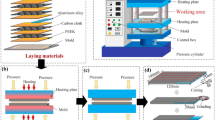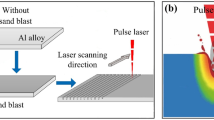Abstract
Laser direct joining of carbon fiber-reinforced thermoplastic composites (CFRTP) to aluminum alloy with diverse surface micro-patterns was performed. The influence of micro-pattern type on interface characteristic and mechanical property of CFRTP/aluminum alloy laser bonding joint was concerned especially. Prior to the laser joining, two different micro-patterns including groove structure and circular hole structure were fabricated on the metal surface using nanosecond pulsed laser. Then, the appearance of joint and the morphology at joining interface were observed by optical microscope and scanning electron microscope. Moreover, the tensile shear test was conducted to obtain the fracture load and fracture surface morphology. The results indicated that the cross section of the groove structure was a trapezoid, while that of the circular hole structure was a triangle with a large ratio of depth to diameter. In spite of the more pores existed at the interface of joints with circular hole structure, this type of micro-pattern strengthened the mechanical anchoring effect between CFRTP and aluminum alloy more significantly. With the change of micro-pattern from groove structure to circular hole structure, the maximum tensile load of laser bonding joint increased from 1616.40 to 2623.40 N, and the main failure mode transformed from interface failure to cohesive failure. The micro-pattern fabricated on the metal surface before the laser joining process is an effective approach to obtain the larger bonding area and higher mechanical strength of laser bonding joint.
















Similar content being viewed by others
Availability of data and material
Data and materials are available.
References
Da Costa AP, Botelho EC, Costa ML, Naritra NE, Tarpani JR (2012) A review of welding technologies for thermoplastic composites in aerospace applications. J Aerosp Technol Manag 4:255–265. https://doi.org/10.5028/jatm.2012.04033912
Du S (2007) Advanced composite materials and aerospace engineering. Fuhe Cailiao Xuebao/Acta Mater Compos Sin 24:1–12
Zhan X, Li Y, Gao C, Wang H, Yang Y (2018) Effect of infrared laser surface treatment on the microstructure and properties of adhesively CFRP bonded joints. Opt Laser Technol 106:398–409
Tsouvalis NG, Karatzas VA (2011) An Investigation of the tensile strength of a composite-to-metal adhesive joint. Appl Compos Mater 18:149–163
Gray PJ, O’Higgins RM, Mccarthy CT (2014) Effect of thickness and laminate taper on the stiffness, strength and secondary bending of single-lap, single-bolt countersunk composite joints. Compos Struct 107:315–324
Kelly G, Hallstroem S (2004) Bearing strength of carbon fibre/epoxy laminates: effects of bolt-hole clearance. Compos B 35:331–343
Chen N, Luo H, Wan M, Chenot JL (2014) Experimental and numerical studies on failure modes of riveted joints under tensile load. J Mater Process Technol 214:2049–2058
Hopmann C, Kreimeier S, Keseberg J, Wenzlau C (2016) Joining of metal-plastics-hybrid structures using laser radiation by considering the surface structure of the metal. J Polym 2016:1–10
Wang H, Chen Y, Guo Z, Guan Y (2019) Porosity elimination in modified direct laser joining of Ti6Al4V and thermoplastics composites. Appl Sci 9
Nagatsuka K, Tsuchiya A, Nakata K, Yoshida S (2015) Direct joining of carbon-fiber-reinforced plastic to an aluminum alloy using friction lap joining. Compos Part B Eng
Li Y, Bu H, Yang H, Liu G, Zhan X (2020) Effect of laser heat input on the interface morphology during laser joining of CFRTP and 6061 aluminum alloy. J Manuf Process 50:366–379. https://doi.org/10.1016/j.jmapro.2019.12.023
Tan C, Su J, Zhu B, Li X, Feng J (2020) Effect of scanning speed on laser joining of carbon fiber reinforced PEEK to titanium alloy. Opt Laser Technol 129:106273
Jiao J, Xu Z, Wang Q, Sheng L, Zhang W (2018) CFRTP and stainless steel laser joining: Thermal defects analysis and joining parameters optimization. Opt Laser Technol 103:170–176
Fortunato A, Cuccolini G, Ascari A, Orazi L, Campana G, Tani G (2010) Hybrid metal-plastic joining by means of laser. Int J Mater Form 3:1131–1134
Holtkamp J, Roesner A, Gillner A (2010) Advances in hybrid laser joining. Int J Adv Manuf Technol 47:923–930
Wang X, Li P, Xu Z, Song X, Liu H (2010) Laser transmission joint between PET and titanium for biomedical application. J Mater Process Technol 210:1767–1771
Bergmann JP, Stambke M (2012) Potential of laser-manufactured polymer-metal hybrid joints
Zhang Z, Shan JG, Tan XH, Zhang J (2016) Effect of anodizing pretreatment on laser joining CFRP to aluminum alloy A6061. Int J Adhes Adhes 70:142–151
Arai S, Kawahito Y, Katayama S (2014) Effect of surface modification on laser direct joining of cyclic olefin polymer and stainless steel. Mater Des 59:448–453
Cenigaonaindia A, Liebana F, Lamikiz A, Echegoyen Z (2012) Novel strategies for laser joining of polyamide and AISI 304. Phys Procedia
Rodríguez-Vidal E, Sanz C, Soriano C, Leunda J, Verhaeghe G (2016) Effect of metal micro-structuring on the mechanical behavior of polymer–metal laser T-joints. J Mater Process Technol 229:668–677. https://doi.org/10.1016/j.jmatprotec.2015.10.026
Rodríguez-Vidal E, Sanz C, Lambarri J, Quintana I (2018) Experimental investigation into metal micro-patterning by laser on polymer-metal hybrid joining. Opt Laser Technol 104:73–82
Zhang Z, Tan XH, Zhang J, Shan JG (2018) Suppression of shrinkage porosity in laser-joining of CFRP and steel using a laser surface modification process “Surfi-Sculpt.” Int J Adhes Adhes 85:184–192
Enami K, Kimura F, Yokoyama K, Murakami T, Kajihara Y (2020) Experimental and simulative investigation of the effects of laser-structured metal surface on metal-polymer direct joining. Precis Eng 62:273–281. https://doi.org/10.1016/j.precisioneng.2019.12.011
Boinovich LB, Modin EB, Sayfutdinova AR, Emelyanenko KA, Vasiliev AL, Emelyanenko AM (2017) Combination of functional nanoengineering and nanosecond laser texturing for design of superhydrophobic aluminum alloy with exceptional mechanical and chemical properties. ACS Nano 11:10113–10123. https://doi.org/10.1021/acsnano.7b04634
Zhang Z, Shan J, Tan X, Zhang J (2017) Improvement of the laser joining of CFRP and aluminum via laser pre-treatment. Int J Adv Manuf Technol 90:3465–3472. https://doi.org/10.1007/s00170-016-9646-5
Author information
Authors and Affiliations
Contributions
The material preparation, micro-pattern fabrication and the laser direct joining experiment were conducted by FW. Data processing and manuscript preparation were led by FW with contributions from all authors.
Corresponding author
Ethics declarations
Ethics approval
Not applicable.
Consent to participate
Not applicable.
Consent for publication
All authors have read and agreed to the published version of the manuscript.
Conflict of interest
The authors declare no competing interests.
Additional information
Publisher's Note
Springer Nature remains neutral with regard to jurisdictional claims in published maps and institutional affiliations.
Rights and permissions
About this article
Cite this article
Wang, F., Bu, H., Luo, J. et al. Influence of different micro-pattern types on interface characteristic and mechanical property of CFRTP/aluminum alloy laser bonding joint. Int J Adv Manuf Technol 120, 3543–3557 (2022). https://doi.org/10.1007/s00170-022-08748-6
Received:
Accepted:
Published:
Issue Date:
DOI: https://doi.org/10.1007/s00170-022-08748-6




